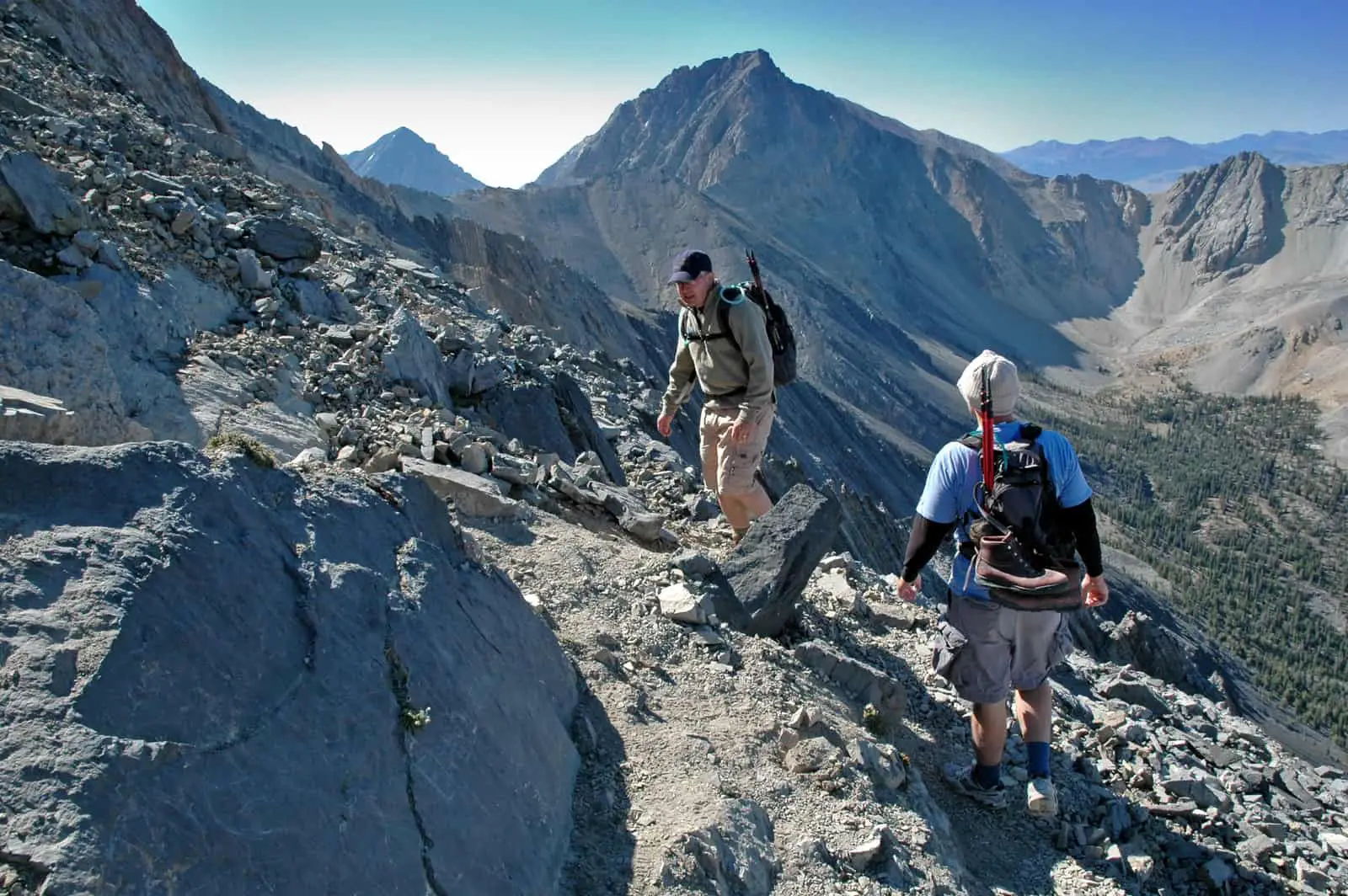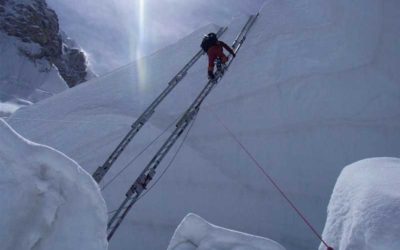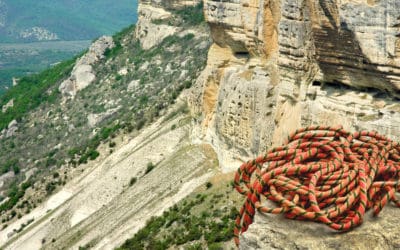
I’m guessing that you are in either one of these situations: you have mountaineering boots and are unsure if you need to buy hiking boots for your next trip, the other way around, or you have both but you’re afraid that you will pack too heavy if you bring both.
Don’t worry, hopefully, I’ll help you decide if you’re leaning one way or the other.
Can you hike in mountaineering boots or should you bring an extra pair?
In short, hiking Boots are specifically made for walking, mountaineering boots are multi-purpose. Hiking can be done in most mountaineering boots, but for long hikes you lose both time and energy efficiency. If you have a lot of space in your packing, bringing both can be viable.
So, that means only one pair of boots is enough for all mountains? Well, it depends – on a lot of things, as it turns out.
In this article, I will unpack the practicalities of hiking in mountaineering boots, hopefully helping you decide whether lugging that extra pair of boots along is worth it or not.
Contents
Reasons You Should Only Bring Mountaineering Boots
First off, mountaineering boots and hiking boots are not the same. While some mountaineering boots lend themselves to comfortable hiking, many don’t.
There are a few major differences between the two – the one you end up using will depend on what you need for a specific trip (or trips).
Crampons are Better With Hard Boots
Mountaineering boots are meant to be used with crampons when you’re climbing in Alpine regions. For this reason, they are specifically suited to crampons.
Some hiking boots are compatible with specific brands of crampons, but a lot of them aren’t.
If you’re heading for a trip where you need crampons, make sure to fit them first. You don’t want to find out that your boots aren’t suited for your crampons when you’re in the middle of nowhere.
Walking Speed Difference
I know it may seem like a factor not worth considering for many beginners, but there can actually be a big difference between walking in mountaineering vs hiking boots.
As a test, me and my brother walked 8 kilometers uphill on mixed tarmac and dirt. He was wearing La Sportiva mountaineering boots (Trango Tower GTX), and I was wearing low hiking shoes (could be used for running).
Believe it or not but I actually did almost double his pace. And otherwise, we hold pretty much the same pace.
Not to mention that he was definitely more tired afterward than I was, because of the weight difference.
Mountaineering Boots Are So Stiff
Why are mountaineering boots so stiff, though?
The answer lies in how you use crampons: when you’re making your way up a snowy slope, you kick in with your feet, anchoring with the spikes around the toe of your boot.
Your entire weight must be held there while you dig in your other foot for the next step. To do this comfortably, you need something solid to stand on: your boot.
If the soles weren’t stiff, you would have to stand on your toes, tiring your calf and foot muscles a lot more quickly and possibly getting injured quite badly in the process.
Stiff shoes spare your muscles and allow you to climb much more comfortably.
Ankle Support
Mountaineering boots offer higher and stiffer ankle support than their hiking cousins.
The amount and height of this support varies between models, enabling you to shop around until you find what you need.
Warmth and insulation differences
Generally, mountaineering boots are warmer than hiking boots.
Some models even come with a removable liner, perfect for those freezing winter trips.
Hiking boots tend to be less insulated, although you do get some that are suited for sub-zero conditions.
If you are doing any mountains above 3000 m, I’d consider the weather conditions when choosing boots, even if it’s just a ‘’hike’’.

My La Sportiva: Trango Tower GTX. I wouldn’t recommend them for long hikes, however my feet are quite wide. They are a great option for anyone new getting into mountaineering. You can find them on Amazon here.
Reasons You Want Hiking Boots
These are the main reasons why you would want to bring hiking boots over mountaineering boots, or both:
Hiking Boots Are Usually Lighter
Mountaineering boots are generally heavier than hiking boots because they’re made from much more material. It’s as simple as that.
You do get some lightweight mountaineering boots, but these are generally hellishly expensive.
Hiking boots are lighter, so it’s less weight to lug with you as you go – a definite plus when you’re getting tired at the end of a long slog.
Sole Stiffness
Mountaineering boots are stiffer than hiking boots, specifically to accommodate ice climbing with crampons.
The shank of the mountaineering boot won’t bend while you walk, while the hiking boot tends to be softer, making for a more comfortable walk.
So, when choosing between the two, know the proportions of walking and alpine climbing you’re likely to encounter on your route and choose wisely.
If The Approach Is Really Long
If your mountaineering boots don’t fit properly, your feet will probably start hurting during approach or other walks on flat ground.
You can remedy this by adjusting the way you tie your laces.
Specifically, don’t tie the top loops too hard.
Some climbers also recommend getting a personally optimized inner sole for your boot, since this can mitigate a lot of the problems associated with using mountaineering boots for hiking.
That said, these shoes aren’t generally meant for walking on flat ground, so you can’t expect it to be as comfortable as when using proper hiking boots.
Hiking boots are also generally manufactured from softer materials, giving them a softer feel around your feet than mountaineering boots.
You can even get proper leather hiking boots, which are luxurious.
Mountaineering boots, often manufactured from high-grade plastics, tend to feel harder and stiffer. They’re definitely not cozy, that’s for sure.
Hiking Boots are More Comfortable
Hiking boots tend to be more comfortable than mountaineering boots since they’re specifically made for walking, not climbing.
Mountaineering boots are generally less comfortable, since they’re stiffer and meant for climbing in ice and snow.
If you’re facing a trip with much more hiking on dirt and rock, you might want to opt for a pair of properly insulated hiking boots instead of mountaineering boots.
Why Hike in Mountaineering Boots?
Why would people hike in mountaineering boots? They’re heavier and less comfortable and clearly not meant for hiking, after all.
There are many reasons, chief among them being convenience and ignorance, I guess.
Convenience
if you’re heading for a route that has a lot of technical, alpine climbing, along with some hiking, it may be worthwhile doing the hiking parts in less comfortable shoes, just to save on having to pack an extra pair of boots.
Extra boots mean extra weight in your pack. It also means that you have to change shoes on the trail, which is time-consuming.
You have to take off your pack, find a safe space to put it (you don’t want it rolling down the slope or falling down a cliff), rummage for your boots, change shoes, repack your pack and get it on your back again. Phew! What a mission! Then, if you’re a bit clumsy, you could get your feet wet in the process. Definitely not fun.
Or, maybe you’re only heading out for a day hike and you’re new to the sport. The only pair of boots you could find in a hurry is a pair of old mountaineering boots your friend lent you.
Hey, I’ve been there. If that’s all you have and you really want to give this mountaineering/hiking thing a try, I’m all for it.
Ignorance
Some people really just don’t know better, blindly trusting what the salesperson (who gets a commission, so wants to sell the most expensive thing in the shop) tells them.
It’s well worth your while to do a bit of reading up before heading for the shop, knowing more or less what you want and need before you get there.
Conclusion
Mountaineering boots are not always the best for hiking, but they can work. You even find some hybrid models that are meant to do both.
When deciding whether you should do your trip in mountaineering boots or go through the effort of lugging and an extra pair of boots with, know what you’re in for.
Read up on the route you’re taking, ask others who have done it recently what the conditions are like and make an informed decision.
You only get one pair of feet, so make sure that you take proper care of it. Hiking in uncomfortable boots can really put a damper on your trip.
That said, it’s your choice. Whichever option you choose, hike responsibly and enjoy. Happy Adventures!
Written by Felix

About me
Hi! I’m Felix. When I’m not spending time out in the mountains, I like to write about my hobbies. That is how Mountain Homies was created. On this site, I try to gather all the juicy information about Mountaineering that I have learned since I started. Happy adventures!
Related Articles
3 Ways to Spot and Reveal a Crevasse (And Avoid It)
So, how do you spot a crevasse and – more importantly – avoid falling into one? In this article, I will have a look at what crevasses are and how to detect them…
3 Clever Ways of Crossing A Crevasse
When you’re mountaineering in snow country, you will undoubtedly encounter some crevasses. These are scary, since you don’t always spot them…
Mountain Climbing vs Rock Climbing: 5 Biggest Differences
The key differences between rock climbing and mountain climbing are the gear requirements, environmental risk, geographical locations, weather and…
Stay Up to Date With The Latest News & Updates
Join Our Newsletter
The owner of this site is a participant in the Amazon Services LLC Associates Program, an affiliate advertising program designed to provide a means for sites to earn advertising fees by advertising and linking to amazon.com.




